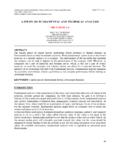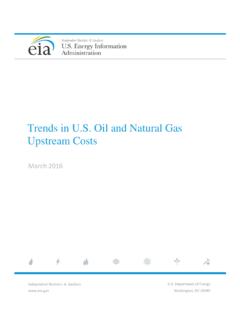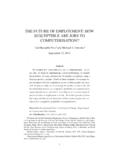Transcription of Technology Life-Cycles & Technological Obsolescence
1 Technology Life-Cycles And Technological Obsolescence Copyright BCRI Inc. Stephen L. Barreca, PE, CDP. Abstract Traditional mortality studies alone are insufficient to assess the depreciation of utility property that is subject to Technological Obsolescence . There are two principle reasons for this. First, Technological Obsolescence is having a more profound impact on the future economic life of utility property today than it had in the past. Second, the current mortality analysis process, , using a single mortality survivor curve for all vintage for all future years, grossly understates the true impact of Technological Obsolescence . Several writings, published in the early 1980's, document this fact; yet, the current process, developed in the first half of this century, remains unchanged today. Fitch and Wolf in their paper, titled Conceptual Framework for Forecasting the Useful Life of Industrial Property, Iowa State Regulatory Conference, 1984, recognized the need to enhance the Prescribed Projection Life process and conceptualized on how forward-looking impacts such as Technological Obsolescence could be modeled to give better life estimates.
2 K. A. Kateregga, Department of Industrial Engineering, Iowa State University, concluded in his paper Technological Forecasting Models and Their Applications in Capital Recovery, that there is a justifiable need to incorporate Technological forecasting in the overall life analysis framework especially in those industries experiencing fast Technological changes.. This paper presents a methodology that will allow the influences of Technological Obsolescence to be reasonably assessed and reflected in the economic life and depreciation of the plant. It proposes that the analyst use Historical Mortality analysis to assess the influence of traditional forces of mortality, and an extension of Substitution analysis to determine the impacts resulting from Technological Obsolescence . Each of these techniques is common practice and has proven accurate in the context of their use within this paper.
3 The total mortality rate is then computed by statistically combining the influences from both traditional mortality analysis and Technology substitution analysis . Finally, the life, value and/or depreciation of the property can be determined using commonly accepted life-cycle techniques. -1- BCRI Inc. Technology Life-Cycles & Technological Obsolescence Background Depreciation is a measure of the loss in service value incurred in connection with the consumption or prospective retirement of the property1. In the context of capital recovery studies, the goal is to book depreciation expense commensurate with the consumption of the asset. To determine depreciation adequately, the influence of all factors that measurably contribute to depreciation must be determined. Failure to adequately account for any significant contributor will understate the magnitude of depreciation, and overstate the true value of the asset.
4 In practice, separately quantifying the depreciation contribution of all potential influences is not practical and, luckily, not required. Depreciation generally results from two principle classes of loss: traditional mortality forces and Technological Assessing the mortality characteristics of just these two classes of forces can capture most, if not all, significant influences on the depreciation of utility property. For most of this century, Historical Mortality analysis (HMA) provided a reasonable estimate of the economic lives and loss in value of utility property. Before the 1970s, the overwhelming drivers of mortality for utility property were traditional mortality forces: wear and tear, deterioration, etc. These forces are typically a constant function of the age of the asset and do not change with the passage of time. For example, 5 years ago, 10. year old assets may have had a 3% retirement rate; today, 10 year old assets would still have a 3% retirement rate; and 30 years from now, 10 year old assets would still have a 3% retirement rate.
5 This concept is fundamental to HMA. When used to model traditional forces of mortality, HMA has proven reasonably effective. Some assets, like utility poles, still exhibit characteristics consistent with HMA. With the onslaught of rapid Technological Obsolescence , however, experience has proven HMA ineffective. The reason for this is simple: when Technological Obsolescence is present, mortality rates increase with the passage of time. Reliance on past mortality experience as the basis for future mortality patterns understates the true mortality of utility property, understates the depreciation requirement, and overstates the remaining life and value of the assets. Because of HMA's inability to model mortality forces that change with the passage of time, another technique must be used to assess Technological Obsolescence . HMA should still be used to assess traditional age-dependent forces of mortality, however, Technological Obsolescence must be separately addressed using techniques that account for its unique mortality characteristics.
6 The technique presented in this paper to address the unique characteristics of Technological Obsolescence is an extension of Substitution analysis . 1. Public Utility Depreciation Practices, National Association of Regulatory utility Commissioners (NARUC), 1996, page 318. 2. Different regulatory bodies and corporations may have specific local definitions for depreciation related terms, and may classify the forces contributing to an asset's loss in value differently than presented in this report. The state of Indiana, for instance, classifies wear and tear from usage as a form of Obsolescence , whereas this report classifies wear and tear as a traditional' force of mortality. How one classifies the different forces of mortality is a matter semantics and local custom, and not germane to the results. For the purposes of this analysis , mortality forces are classified in a manner thought to best promote their understanding.
7 -2- BCRI Inc. Technology Life-Cycles & Technological Obsolescence Assessing Traditional Forces of Mortality Traditional Forces of Mortality, in the context of this paper, refers to those forces of mortality that can be reasonably modeled as a constant function of the age of the asset. That is, the likely mortality of an asset in a given year and for a given age of plant (vintage) is constant. Traditional mortality generally results from usage and exposure to the elements. Specific forces of traditional mortality include wear and tear through usage, deterioration with age, accidental or chance destruction, and most requirements of public authorities. Provided that the group of assets being studied is homogeneous3, you can readily model traditional mortality as a constant function of age. For example: Accumulated usage of an asset is nearly a constant function of its age. Wear and tear of an asset resulting from accumulated usage is, therefore, also a constant function of age.
8 Similarly, some forms of deterioration are a direct function of age, while others are a function of accumulated exposure to the elements, which in turn is a constant function of age. Accidental or chance destruction is more a function of the environment surrounding the asset and constant for all age groups. Incidental losses due to public requirements, such as a road move, are also included with traditional mortality forces. Given the incidental and random nature of such mandates, they too are reasonably modeled as a constant function of the age of the plant. The commonly accepted method of assessing the impact of traditional forces of mortality is Historical Mortality analysis (HMA). The HMA process typically involves developing the mean probability of loss ( retirement rate) for each age of plant. Generally, this entails statistical analysis of past retirement experience.
9 The resulting mortality patterns are then reflected in a mortality survivor curve, which plots the anticipated percentage of initial survivors still surviving as the age of the assets increases. Figure 1 illustrates a typical survivor curve. 3. Homogeneous, in this context, indicates that the group of assets has similar life and mortality characteristics. -3- BCRI Inc. Technology Life-Cycles & Technological Obsolescence Figure 1 Typical Mortality Survivor Curve 100%. 90%. Sn = Survivors for age n'. 80% Dn = Expected retirements this S6. 70% S7 D6=S6-S7 year for n-year old property Percent Surviving 60% Rn = Retirement Rate = Dn/Sn 50%. 40%. 30%. Portion of 20% Survivor Curve used for the 6. 10%. year old vintage 0%. 0 1 2 3 4 5 6 7 8 9 10 11 12 13 14 15 16 17 18 19 20 21 22 23 24 25. A g e o f P r o p e r ty Figure 1 also illustrates how to use survivor curves to project the future mortality for a given vintage.
10 Consider a six-year old vintage that has traditional mortality characteristics consistent with the survivor curve of Figure 1. From the survivor curve, the expected retirements for the current year equals the survivors for age 6 less the survivors for age 7. (S6-S7). The retirement rate for the current year, denoted as R6, equals the retirements divided by the current survivors, or (S6-S7)/S6. These calculations can be repeated for all subsequent years. For example, the expected retirement rate for the next year, for this vintage, is R7 = (S7-S8)/S7. Thus, the mortality survivor curve also gives us the future annual probabilities of loss ( , retirement rates) for each Additionally, it is common practice to estimate the remaining life of the vintage as the remaining area under the mortality survivor curve (the shaded area shown in Figure 1). divided by the surviving investment (S6 in this case).





